2012 Sportster 1200 Nightster
In 1957, Elvis Presley released the hit song "All Shook Up", the first Frisbee was produced, and the Harley-Davidson Sportster model motorcycle was introduced. This is the start of the great Harley-Davidson Sportster history. Known as the XL series, and with many of the same characteristics as it's K model ancestor, such as the frame, fenders, gas tank and front fork. The Sportster is still being produced today, and it retains its status of being one of the world's most popular motorcycles.
Harley Davidson K Model
The Sportster is a direct descendant of Harley's legendary but sometimes-overlooked Model K series.
The middleweight K model was introduced in 1952, with a 45 cubic inch flathead engine, and a unit construction four-speed transmission that was contained inside the engine cases. Later models of the K series Harleys were equipped with 55 cubic-inch engines.
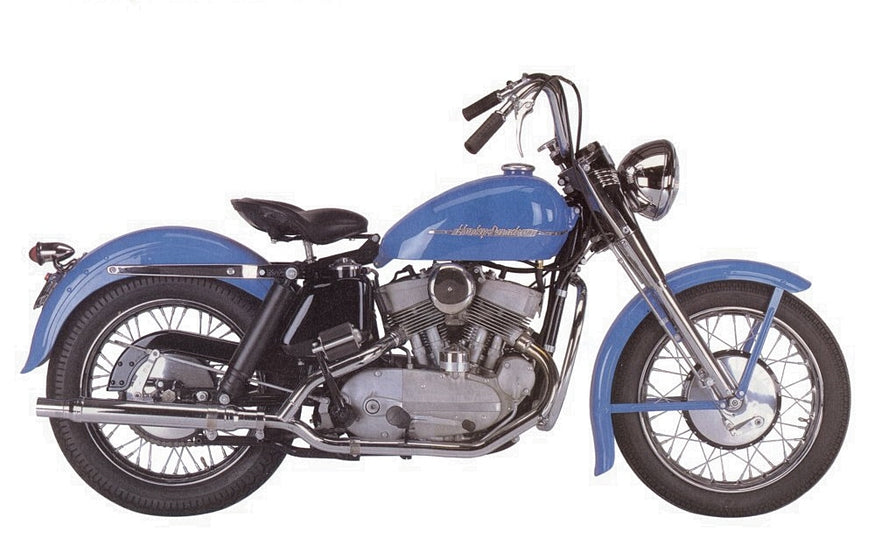
Harley-Davidson 1952 K Model.
The K model Harleys were the first models to sport a hand-clutch and a foot-gear shifter. The design was opposite that of the Harley-Davidson Big-Twin models, with the foot-brake lever on the left side of the bike, and the gear-shifter on the right side.
One of the mechanical advances offered on the K models was the inclusion of hydraulic suspension systems on both wheels. The K models were the first civilian cycles made by Harley-Davidson that featured hydraulic front forks, and a swing-arm in the rear that contained two shock absorbers.
When the Sportster debuted, it closely resembled the K models in appearance, but the K model's 45 cubic-inch engine was replaced with a more powerful 54 cubic-inch, overhead-valve powerplant that was known as the ironhead motor because of the iron cylinder heads that were used. Ironhead motors were used to power Sportsters from 1957 through 1985.
In 1986 the ironhead engines were replaced with the new Harley Davidson Evolution engine. The "Evo" motors were available in 883 cc and 1,100 cc sizes.

The Harley-Davidson 1957 XL Sportster.
Harley-Davidson XL Series Sportsters
What does XL mean on a Sportster? The term XL on a Sportster means Experimental Lightweight or Extra Light.
XL, Ironhead, 1957-1985
The dynamic new Sportster represented the start of a new era in American motorcycling. The model was created in part to provide some real competition to the best British Triumphs, BSAs and Nortons that were becoming increasingly popular with American riders. The price of a brand new XL Sportster in 1957 was approximately $1,100.
With its fresh and dynamic appearance, the Sportster became appealing to motorcycle consumers almost immediately. Not only was this cycle as sleek and exciting as the British imports, but it was more powerful, and it was a Harley-Davidson!
By the time the 1958 XLCH models came out, the Harley-Davidson Sportster engines featured higher compression, with larger valves and domed pistons. The iconic peanut fuel tank also made its entrance that year.
Sportsters made from 1957 through 1990 were outfitted with four-speed transmissions, while models made since 1991 have five-speed gearboxes. The earlier models that had the gear-shift lever on the right side were inspired by Harley-Davidson's impressive flat track racing history.

With minimal parts, being a lot smaller and less weight then big twins, Ironheads made great choppers. Photo labeled Jul - 68.
XLCH, Ironhead ("Competition Hot" moniker) 1958-1971
By the mid-1960s, Sportsters had become very popular with the motorcycling public, and were often being customized. The Sportster's relatively lightweight and clean lines made it an ideal cycle to transform into a chopper or bobber.
The basic image of motorcycling in those days was sometimes portrayed in a negative light, during the history of Harley-Davidson sportster, they consistently presented the Sportster in a clean and positive manner.
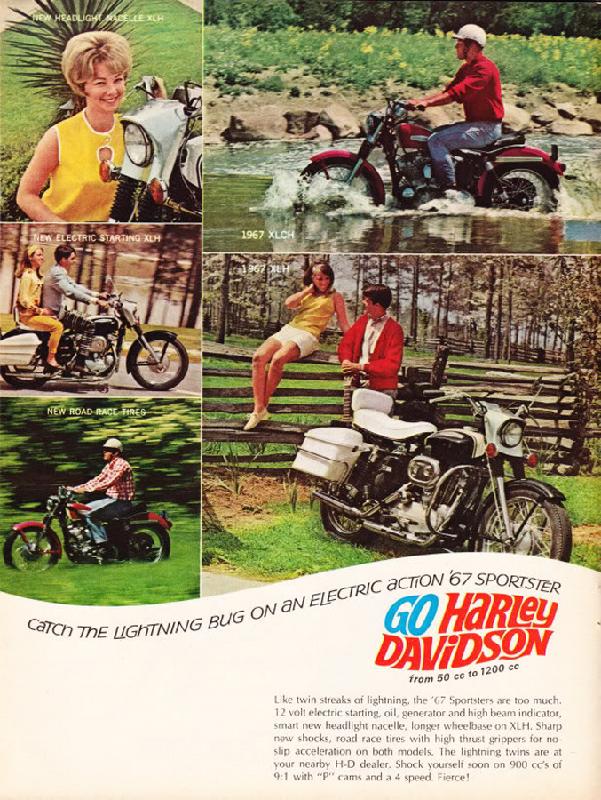
A full color, multi-panel print advertisement for the 1967 Sportster shows a wholesome looking couple riding an XLH through the countryside, and a conservative-looking gentleman riding an XLCH through picturesque rural areas.
Harley-Davidson has been making regular cameos, and from 1969 to 1970, a major network TV show named "Then Came Bronson" was on the air. The program starred Michael Parks as a former newspaper reporter who traveled around on a 1969 XLH Sportster. The show can still be seen in reruns, and is available on DVD.
While the various Sportster models have generally been very well-received by the public through the years, a small percentage of people have claimed that they are too small and lightweight to be considered "real" Harleys. Somewhere along the way, somebody decided to call Sportsters "girl's" or "beginners" bikes.
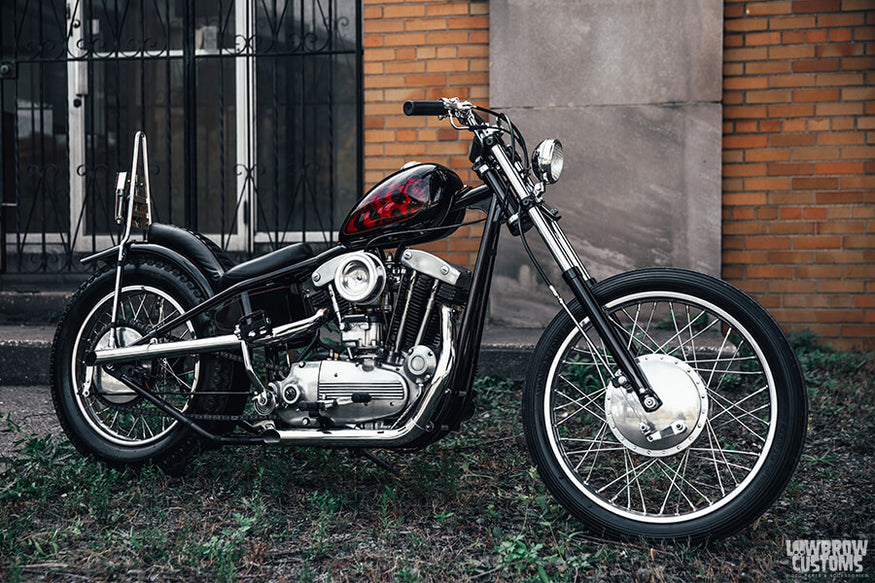
1968 Ironhead sportster built by Terminal Speed - Marcus Ellis
Although the origin of Sportsters being called "girl's" or "beginners" bikes is unknown, it is sometimes attributed to disgruntled Big-Twin owners who were actually jealous of the faster, smaller bikes. Another theory is that the term was devised by an envious sidewalk commando/biker-poser. No matter where the ridiculous term originated, the Sportster suffers from no inadequacy issues, and the term is rarely used today.
XR-750 1971-1985
AMF-era Harleys
During the years that the AMF corporation owned Harley-Davidson, from 1969 to 1981, the company produced a respectable lineup of Sportster models. There were detractors, however, who claimed that the overall quality of the AMF-era Harleys was less-than satisfactory.

- Paul Smith created this poster to celebrate the four founding fathers of Harley-Davidson for the 1976 U.S. bicentennial.
Some motorcycle enthusiasts and collectors think that the Sportsters produced under AMF's ownership were the most attractive of all Sportster models. To this day, the gas tanks in particular from AMF-era Sportsters are highly sought after collector's items.
Among the AMF-era Sportster models that were produced were the Bicentennial Edition in 1976, and the Confederate model from 1977. Designed to honor America's 200th birthday, the Bicentennial Edition bikes were basically regular Sportsters that had special patriotic decals affixed to the gas and oil tanks.
The Confederate Edition Sportster was comprised of XLH, XLCH, and XLT models that featured metallic gray paint with decals that included the Confederate flag. Less than 400 of these largely unknown Sportster models were produced.
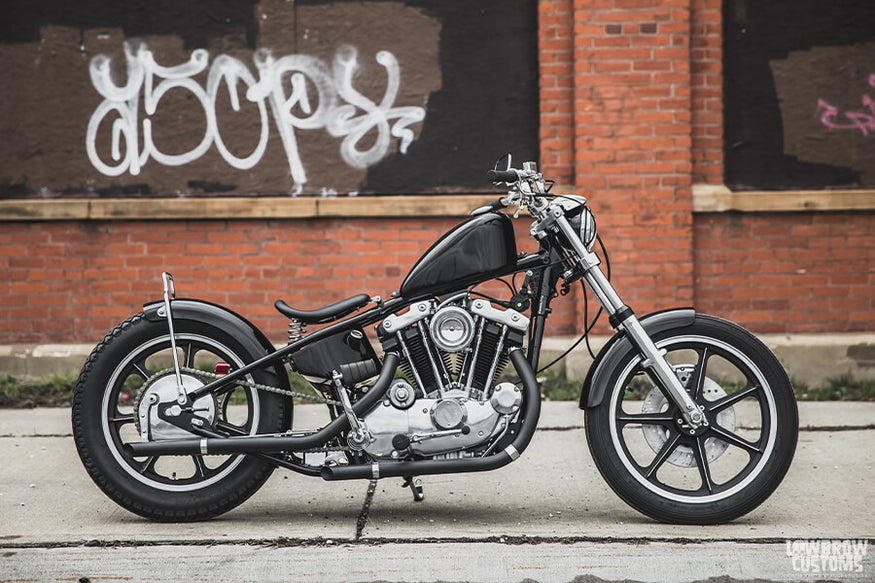
This 1972 Ironhead was built by The Gasbox
In 1972, the standard 900 cc engine was replaced with a 1,000 cc overhead-valve motor. 1975 brought about the government-mandated gear-shifter switch to the left side, and 1979 was the last year that the kickstart-only XLCH model was produced. From 1977 to 1979, Harley produced the 1,000 cc XLCR Cafe Racer, and from 1979-1982 they made the XLS Roadster, with its 2" fork extension, sissy bar and highway pegs.
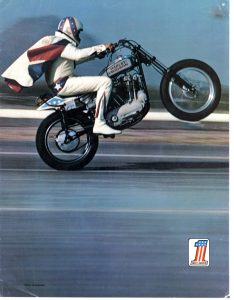
Evel Knievel on his XR-750.
Harley-Davidson XR-750
During the 1970s, stunt rider Evel Knievel thrilled audiences around the world with his incredible aerial motorcycle jumps over various objects. The type of bike that Mr. Knievel used for many years was the Harley-Davidson XR-750. Stunt riders Bubba Blackwell and Doug Danger have also utilized the XR-750 in their motorcycle jumps.
Is the XR-750 a Sportster?A close cousin to the Sportster, the XR-750 has been produced since 1970, and has won more races than any other motorcycle in AMA racing history. Due to consumer demand, Harley-Davidson introduced a street-legal Sportster version of the XR-750 called the XR-1000 in 1983.
In addition to the large impact the Sportster has had on the world of recreational motorcycling, this legendary American bike has also made quite an impact on the world of motorcycle racing.
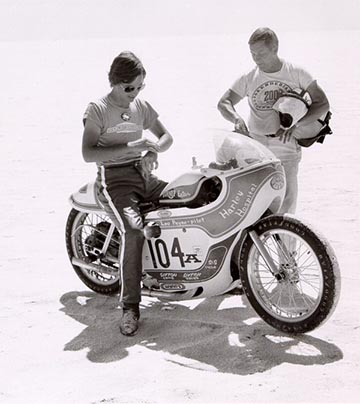
Leo Payne became the first person to reach over 200 mph with a non-streamliner in 1969 on his 1957 Ironhead called the "Turnip Eater".
XL, Evolution, since 1986
How fast are Harley-Davidson motorcycles?
A 265.492mph speed record was set on a Harley-Davidson Sportster in 1970. One of the most famous motorcycle racers of all time was Leo Payne. In 1969, while riding his custom-built Sportster, Mr. Payne was the first person to reach a speed of over 200 mph on a non-streamliner motorcycle at the Bonneville Salt Flats.

Cal Rayborn hit a land speed record of 265.492 mph in this single Ironhead motor powered streamliner at Bonneville in 1970. Harley-Davidson held that record over 5 years.
In 1970, a racer named Cal Rayborn broke the world land speed record for a motorcycle, at the Bonneville salt flats in Utah. The streamliner motorcycle that Mr. Rayborn utilized attained speeds over 260 mph, and was powered by a single Harley-Davidson Sportster engine.
Kickstarters were replaced with electric starters on all Sportsters in 1980, and the stripped-down XLX61 model was introduced in 1983.
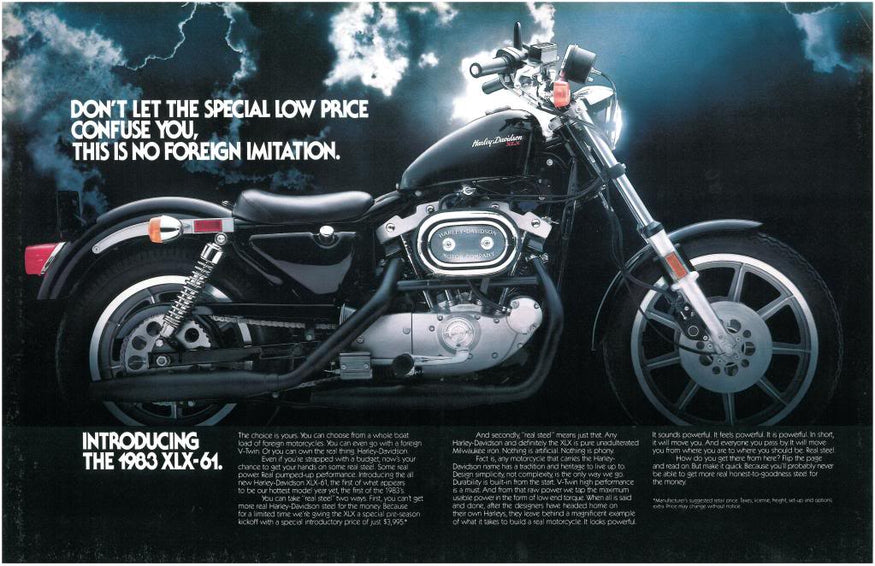
"Don't let the special low price confuse you, this is no foreign imitation." - Harley-Davidson ad for the release of the 1983 XLX-61.
In short: XLH always has an electric starter while XLCH may not, there were no differences between XLH and XLCH in 1973 up at all. This applies for engines too.
XLH Harley-Sportster
The XLH always has an electric starter from 1967, the first year it was introduced. In 1967 only, the XLH had both a kickstart and electric starter, though in 1968 onward XLH models were electric start only, no kickstarter.
To accommodate the larger battery and electric starter, the frame of electric start XLH models was 'kicked back' just above the swingarm pivot. The XLH swingarm was then lengthened accordingly. The oil tank on these models was side mounted on the left side, allowing the room for the battery and starter, as opposed to the center-mounted oil tank.
Seat post tubes were set 1.5" toward the rear, so the upper shock mounts and fender rail mount all were moved rearward. For 1967-1969 there were two frames and engine cases depending on if the bike had electric start (The kickstart-only XLCH continued using the original frame and engine cases during this time. In 1970, the early frames and cases were discontinued. All Sportster models, including the XLCH, shared the frame and engine cases from the XLH electric start models).
XLH models 1971 and earlier had a 4 gallon gas tank. In 1972-73 the customer had the choice of either a 2.2 or 4 gallon gas tank.
XLCH Harley Sportster -What's the difference between XLH and XLCH engine?
XLCH models can be can be kick-only or electric start depending on the year. Prior to 1972 all XLCH models were kickstart only. There were no engine differences for XLH vs XLCH in 1973 up at all. The only way to tell an XLH engine from an XLCH engine is to look at the engine number. The XLH engine number is going to start with a '3A' designation. The XLCH engine number will start with a '4A' designation.1971 and earlier had a 2.2 gallon gas tank. In 1972-73 customers had the choice of either a 2.2 or 4 gallon gas tank, making it harder to differentiate the models.
Rumors persist that the CH in XLCH stands for 'Competition Hot' or 'California Hot', though Harley-Davidson never specified what the designation stood for.
Right-Hand Shift Harley Sportster Years
All XLH and XLCH models were right-hand shift (just like the Triumph, Norton and other British motorcycles they were competing with at the time) up until 1974, though 'Big Twin' Harleys were always left-hand shift. The 1975 and 1976 models were converted to the 'standard' left-hand shift using a crossover linkage. In 1977 the left hand shift became a permanent change with the shifter shaft coming through the primary.
Harley Davidson Released the Sportster 883 in 1988
The Sportster Hugger came on the scene in 1988, and its smaller size was designed to attract beginner, and female riders. This model was essentially an XLH 883 with a lowered rear suspension, different seat, handlebars, and shocks. The Hugger models are actually very similar to the modern "Low" models. Also in 1988, the 1,100 cc Sportster motor was replaced with a 1200 cc engine.
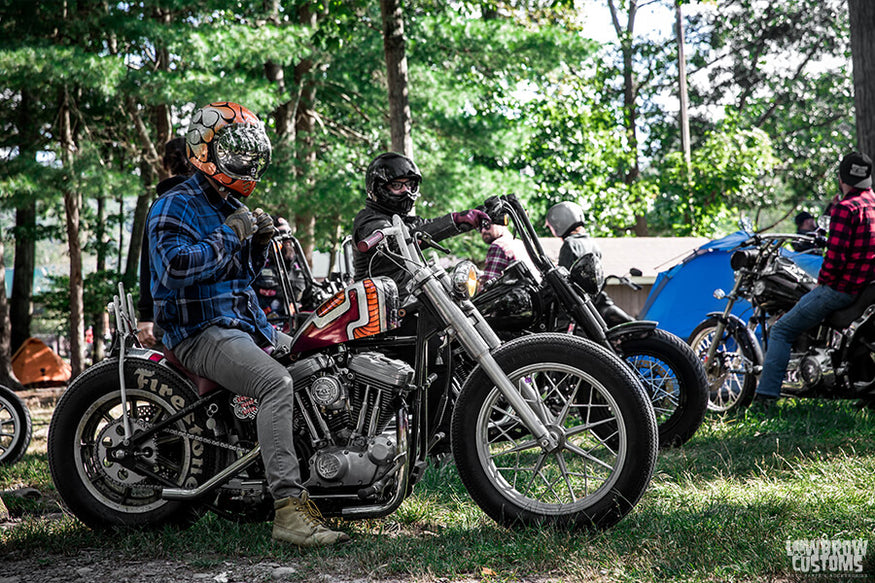
Chain driven custom Sportster.
What are Significant Changes to Harley Davidson Sportster by Model Year?
Belt Drive Made Standard on All Sportsters - 1993
In 1993, the chain drive on Sportsters was replaced with a belt drive, and the following year the electrical systems on the Sportster line were upgraded. The XL 1200C Custom model Sportster arrived on the scene in 1996.
All-New Frame Including Rubber-Mounted Engine for Decreased Vibration - 2004

This fairly stock 2005 Sportster is still a carbureted bike but it's motor is in a rubber-mounted frame.
Changes to the Sportster in 2004 included an enclosed battery, the removal of the transmission access door, and a new frame that featured rubber engine mounts.
Fuel Injection Replaces Carburetor on All Models - 2007
In the year 2007, all Sportster models began using fuel injection instead of a carburetor.
Production and Notable Sportster Models of Recent Years
XR1200 Sportster - 2008
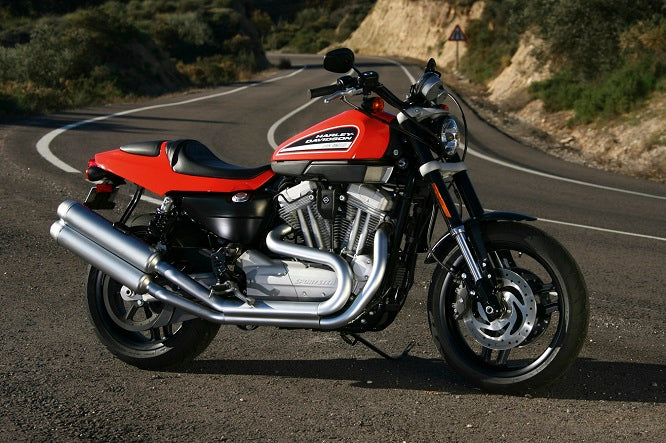
2008 Harley-Davidson came out with the XR1200. It only lasted a 3 year stint on the market.
In 2008, Harley-Davidson entered the modern sportbike market with the debut of the XR1200 Sportster. Somewhat inspired by the XR-750, this model was phased-out in 2011.
XL1200V "Seventy-Two" model Sportster - 2015
In recent years, Harley-Davidson has produced an assortment of factory model 'custom'-style Sportsters. For example, the XL1200V "Seventy-Two" model Sportster is a factory model custom that is inspired by 1970s chopper and bobber-style customs. Introduced in 2012, this stripped-down model features whitewall tires, a peanut fuel tank, pin-striping, high handlebars and metal flake paint.
Other factory model custom-style Sportsters made by Harley-Davidson include the 883 cc and 1200 cc SuperLow, the XL 1200X Forty-Eight, the Iron 883, and the blackened-out Nightster.
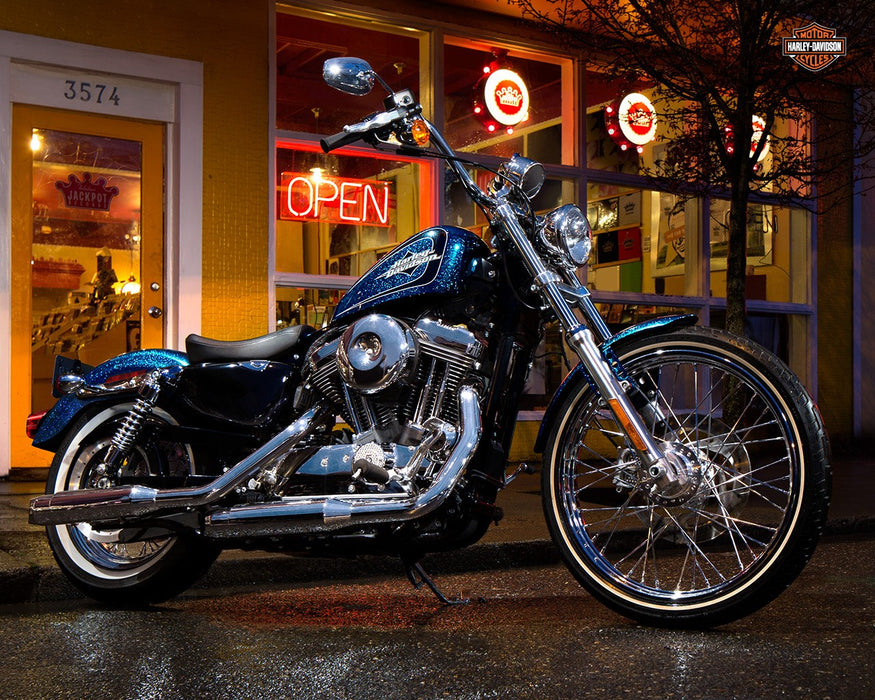
Harley-Davidson 2015 XL1200V "Seventy-Two" model Sportster.
Harley-Davidson Sportster: Tracing the Journey of 60 Years
As the Sportster has evolved through the years, Harley-Davidson has added technological improvements, but the vibrant and exciting bike that debuted in 1957 has stayed true to its roots.
It's hard to believe that the Sportster is now 60 years old. With the variety of advances that the model has experienced, the Sportster has become a ic American machine that requires very little maintenance.
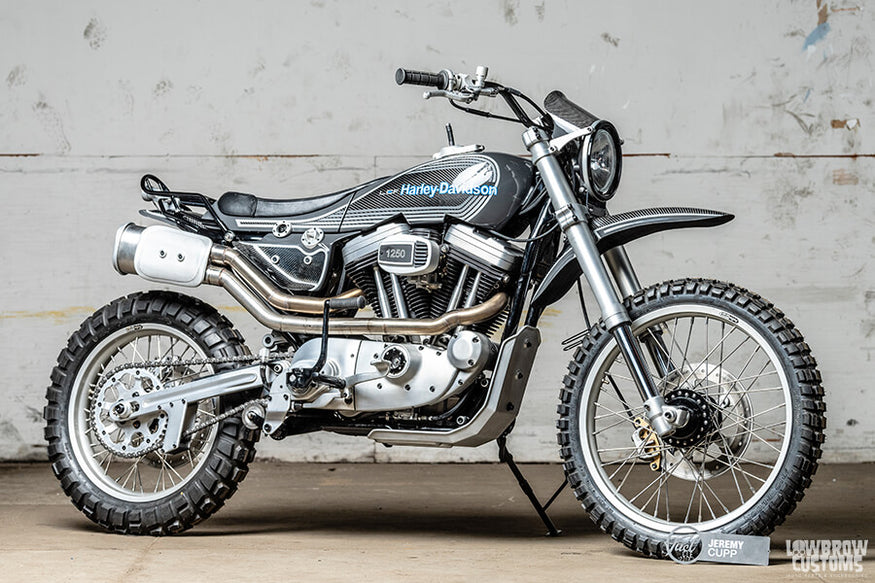
This is a prime example of building whatever you can imagine using a Sportster frame and motor, meticulously crafted by the one and only Jeremy Cupp. Photo by: David Carlo.
Now an iconic part of American culture, the lean and mean Harley-Davidson Sportster is as relevant as it ever was. The model has settled comfortably into the 2000s, and continues to attract new generations of enthusiasts.
Over the past 10 years, Sportsters have experienced another surge in popularity with riders of all ages. Being a fast, attractive, and inexpensive bike that also happens to be a Harley-Davidson makes the Sportster a very appealing vehicle.

Lowbrow Customs Sportster built by The Gasbox. Tons of Lowbrow parts including our Shotgun Pipes, Tsunami fender, and 39mm Fork Shrouds
Even though the various models are just fine in their natural stock form, Sportsters are great bikes to customize.
Lots of Sportster owners like to individualize their bikes by adding custom gas tanks, exhausts, fenders, handlebars and other Harley-Davidson Sportster parts. Whether it be a bobber, chopper, cafe racer, tracker, or roadster-style custom, the Sportster always looks good.
With more than a half-century of production under its belt now, the Harley-Davidson Sportster is still one of the world's most popular motorcycles. It will be interesting to see which direction this ic American motorcycle takes in the future.
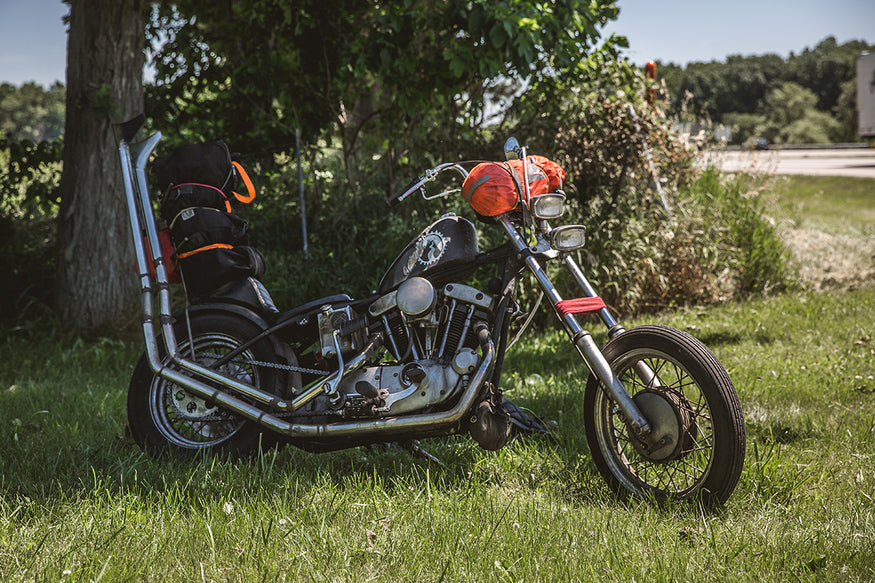
Jay Cagney's '78 Ironhead chopper on our cross country trip in 2016. It did over 3600 miles and rand like a champ.
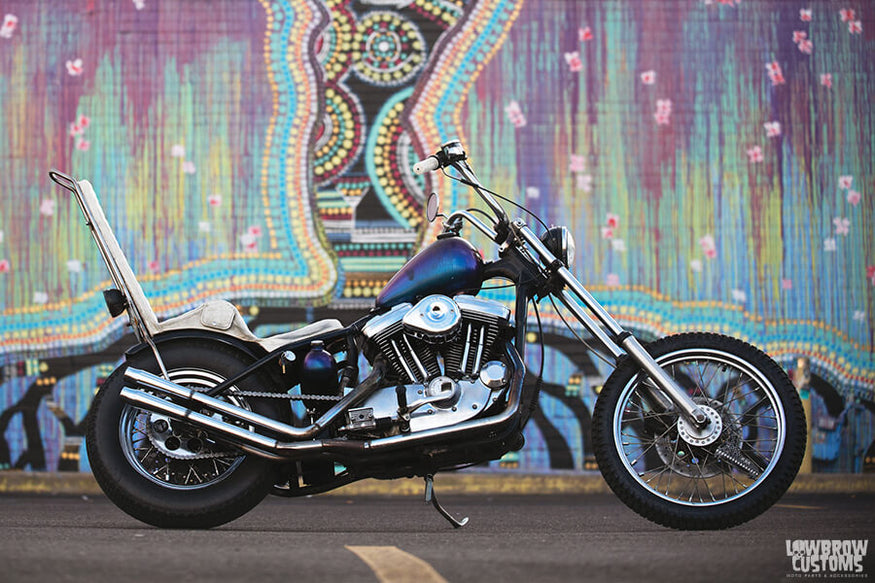
This custom 1996 Harley-Davidson Sportster chopper was built by Virginia Cagney.
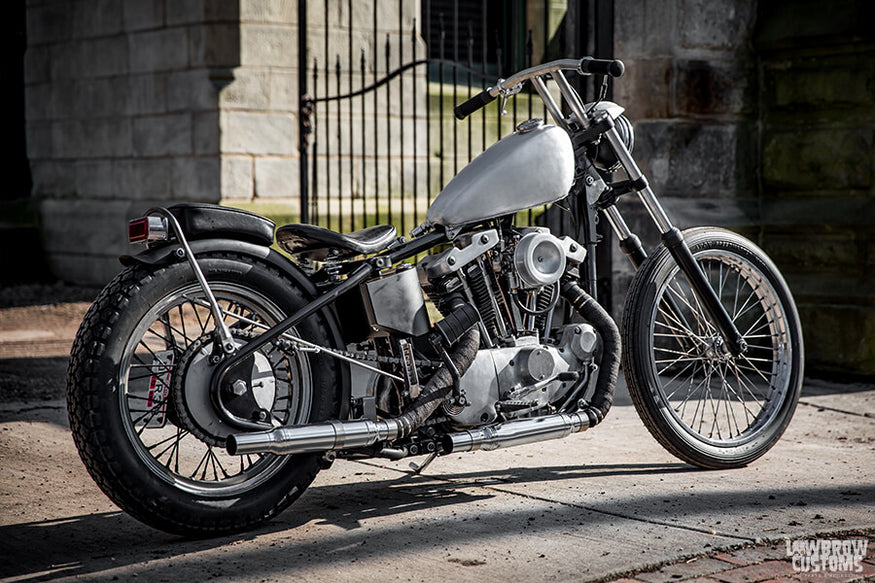
This beautiful 1973 Harley-Davidson Ironhead Sportster was built by Tim Fiorucci.
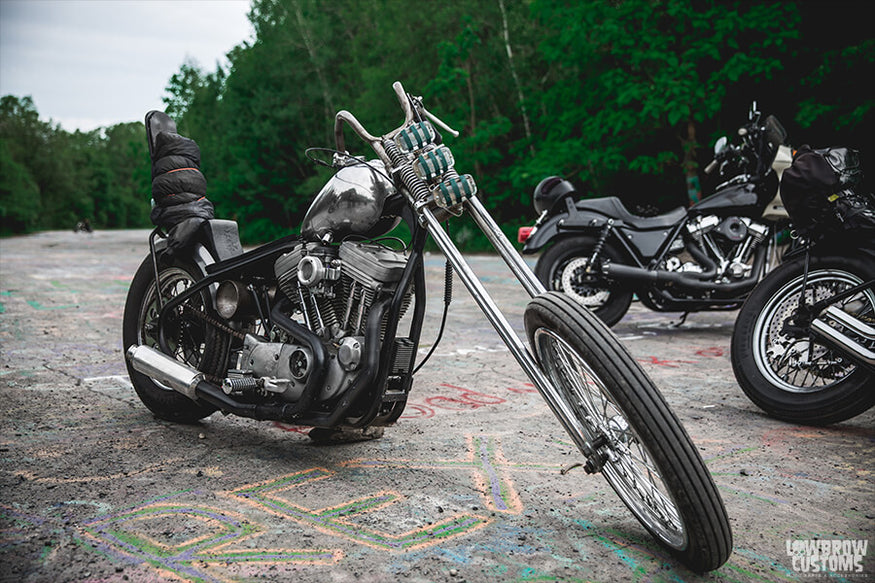
Chris Drew with his long custom Sportster build.
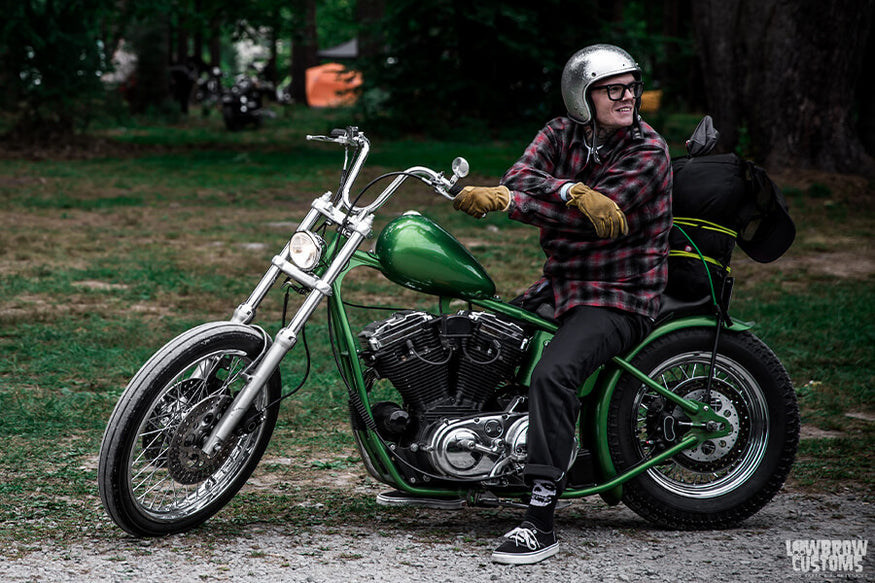
This is a beautiful done sportster chopper by Mike Conti
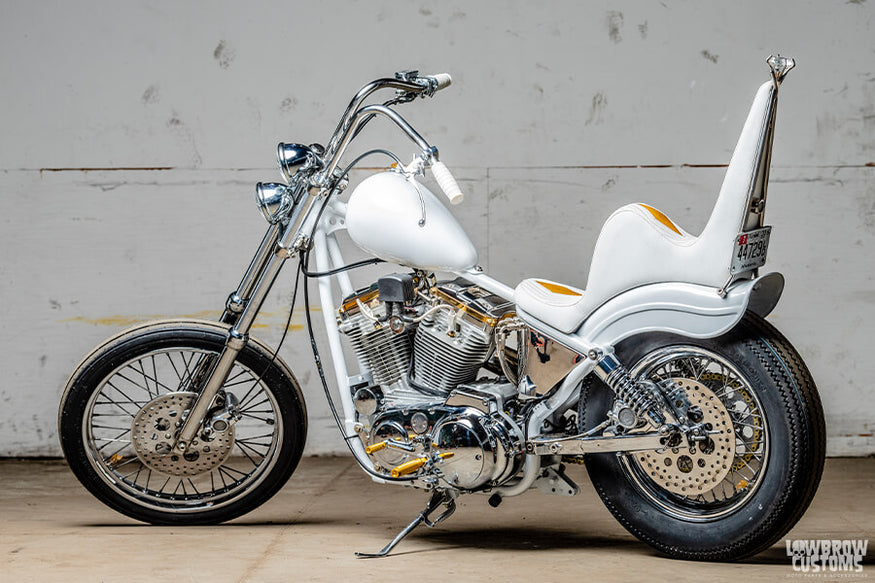
This killer Sporty built by Jason Amelang and owned by Stacey Hearn. Photo by: David Carlo
Source: https://www.lowbrowcustoms.com/blogs/events-features/history-harley-davidson-sportster-blowing-away-big-twins-since-1957

Tidak ada komentar: